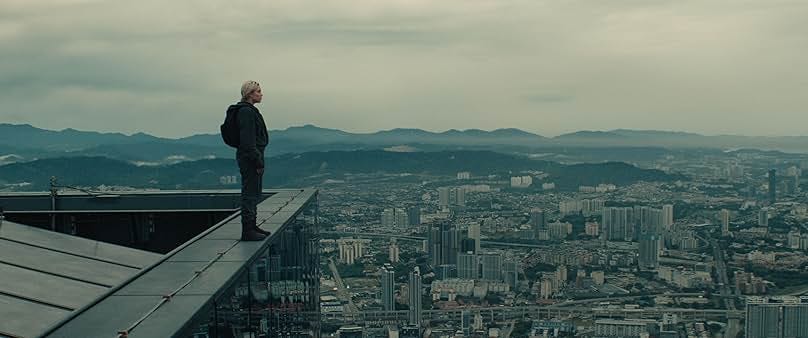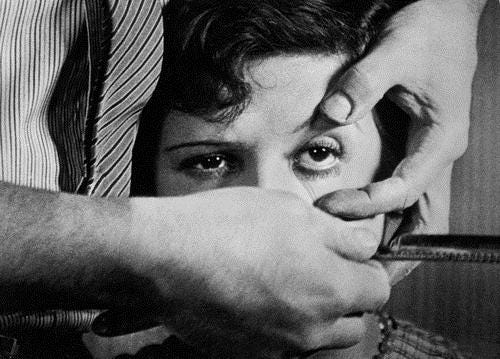The opening scene of the Marvel summer blockbuster Thunderbolts* (the asteriks denotes that the titular ragtag team of arguing misfits might actually be The New Avengers) finds Black Widow assassin Yelena Belova (Florence Pugh) on a cleanup assignment in Malaysia for CIA director Valentina Allegra de Fontaine (Julia Louis-Dreyfus). The scene is a suitable yet routine action-packed raid, plunging the audience headlong with Belova down the side of massive skyscraper, then handily dispatching a entire crew of anonymous baddies. But what characterizes this opening sequence, and the entirety of the film, is an overwhelming sense of malaise. The superhero we’ve come to see is bored—bored with her life, bored with her work routine, and bored with her own unstoppable might. And, for someone who is only occasionally keeping up with the continuing sprawl of the Marvel Cinematic Universe, it was difficult not to be instantly bored right along with her.
There’s a single shot within the opening sequence of Thunderbolts* that’s probably the most thrilling and visually interesting shot in the film. The shot plays well matched with Belova’s voice-over as she despairs about the endless repetition and regimen of her duties—it’s a tired repetition itself of the most copied action choreography in recent memory, the hallway sequence in Park Chan-wook’s 2003 film Oldboy. As Thunderbolts* trudges on, this pervasive, depressive state that Belova finds herself in becomes the emotional core of the film, a reflection of the entire MCU, and an allegory for the state of the summer movie, in general.
After Thunderbolts*, I took in the “final” Mission Impossible movie, which felt trapped in an even deeper crisis of repetition than the Marvel world. Mission Impossible: Final Reckoning is a bizarre and hilarious pile-up of narrative and cinematic tropes crashing headlong into a wall. Spoiler alert: the wall wins. Nick Offerman has the most ridiculous death scene in recent memory. Holt McCallany actually utters the line: “He did it. That son-of-a-bitch actually did it.” And, yes, Tom Cruise hangs off a plane! But this time, he really hangs off a plane. (He also seems to drive the plane with the powers of his own mind, which might make Ethan Hunt a future candidate for the MCU.) While I appreciated the jabs MI: Final Reckoning takes at the MAGA/Q-Anon idiots, the film is as big and idiotic as summer movies can get, and entirely sinks itself via some of most poorly handled flashbacks in recent memory. No movie has ever tried harder to be a “final” movie, only to end on a note that suggests: “Yeah…we’ll probably make another one.”
My screenings of both Thunderbolts* and Mission Impossible: Final Reckoning were prefaced by the trailer for Jurassic Park: Rebirth, yet another film marking a franchise in absurd freefall. If you happen to see movies at an AMC, this will all be accented by the absurd repetition of Nicole Kidman reminding you that the movies take us somewhere “we’ve never been before” …as she gazes in amazement upon images of the Jurassic Park gates and the fourth remake of A Star is Born.
Ten years ago the latest summer blockbuster was the fourth iteration of the Jurassic series, Jurassic World, directed by Colin Trevorrow. Trevorrow is another indie director who went from modest budgets like the Aubrey Plaza/Mark Duplass film Safety Not Guaranteed straight into the gargantuan budgets of the Jurassic franchise. After recently seeing the trailer for the new Jurassic film and, once again, pondering just how deep the rabbit hole of movie franchise repetition can go, I though it might be best met with my own act of repetition.
So, here’s my review of Jurassic World from ten years ago…
Have a happy summer, and thanks again to all ESN subscribers, especially you paid subscribers.
Not a paid subscriber yet? Click on the link below and help keep ESN running.
Or share with the cinephile in your life!
Thanks!
Luis Bunuel and Salavdor Dali famously began their influential Surrealist film Un Chien Andalou with the slice of an eyeball, while the Russian Futurist filmmaker Dziga Vertoz closed his operatic collage film Man With a Movie Camera by melding the human eye with the lens of a movie camera. The opening frames of Jurassic World confront the audience with an eyeball as well, but one that represents a very different relationship to movies than those manifesto-fueled avant-garde masterpieces of the late 1920's. The opening optical confrontation presented by this box-office record-breaking behemoth got me thinking about the ways in which all of these films are very much invested in their sense of themselves as movies. Where Un Chien Andalou and Man With a Movie Camera are both exercises in anti-narrative, privileging non-linearity and anti-realist camera trickery over story, Jurassic World is a post-narrative film, resigned to its repetitious story elements and characterizations, and confined to having a conversation with itself, and us, about its own nature as pure cinema product. In this way, Jurassic World is a perfect gauge for how the medium of film has changed in the intervening 85+ years. It's also a perfect gauge for how the movie industry has changed since the release of the original Jurassic Park.
Like the sullen, inoffensive baby dinosaurs depicted in the film, sentenced to a life of having child after child ride them in circles, Jurassic World is a tired tourist attraction that is excessively aware of the tired gaze of its audience, but even more aware of their gullibility as consumers. The opening scenes of the film are riddled with dialogue that seem to be desperately reassuring the audience that this entry will certainly have "more teeth," while simultaneously sounding utterly hopeless about the fact the film will have any "bite" at all. As Bryce Dallas Howard's corporate liaison Claire states early on to some potential sponsors of the park: "No one's impressed by a dinosaur anymore." What we have in this new entry is a film that looks right at the audience, states that it's a failed product, and then laughs at us for having vaulted it to untold box office success.
To be fair, like the character of young Gray (Ty Simpkins), there are a lot of people out there who, simply put, are just into dinosaurs. The history of cinema holds a long fascination with dinosaurs, from the animated Gertie the Dinosaur (1914), to The Lost World (1925), King Kong (1933), the pioneering stop-action work of Ray Harryhausen, and on through the ever-evolving CGI work of Industrial Light and Magic. Historically, the cinema has served as a magical tourist destination to witness these extinct creatures. Jurassic World conflates this idea of cinema-as-tourism in numerous ways throughout the film.
A few years before the release of the original Jurassic Park, John Urry published an influential book in tourism studies called “The Tourist Gaze” which would define our movie-going preoccupation with these giant reptiles as a Collectivist Gaze--the same type of mass, pre-packaged tourist experience depicted as the central location of the film. Tourists who flock to theme parks are central to the Collectivist Gaze--you see them running in colorful, multi-cultural, chaotic streams as the new, mutant products of this entry easily pick them off. Tourists who stray from the Collectivist path, like brothers Zach and Gray in their protective "eye-pod" deciding to go off-roading, are travelling into the realm of what Urry would call the Romantic Gazer, solitary and in search of the Authentic.
The Jurassic films of the past have allowed audiences to travel these imagined borderlands of the gaze, but Jurassic World truly falls short when it comes to discovering anything authentic. In fact, much of the film feels like it takes place in "Meta-World," with the Gen-Y dinosaur monitor Lowery (Jake Johnson) explaining how he got his Jurassic Park T-shirt on e-bay, extolling the authenticity of the original; Claire's exasperated comment about a potential "Verizon Wireless" sponsored attraction; the vigorously infused product placement involving not only the park's Margaritaville outlet, but a Jimmy Buffet-penned song on the soundtrack to boot. Once again, our sense of ourselves as consumers is a primary concern of Jurassic World, almost to an extent that would make German theatre practitioner Bertolt Brecht take interest, were it not so narrowly focused on capitalist gain. Brecht was a pioneer of meta-theatrical techniques who was invested in continually reminding his audience of their role as spectators, and the constructed aspects of spectacle. Brecht saw this awareness as essential to liberating audiences from the dark goals of propagandists and myth-makers after WWI. In Jurassic World, utilizing the main attraction of the theme park as an antidote to war is a theme that echoes this sentiment throughout. Yet, the film’s villain, Hoskins (Vincent D’Onofrio), comes to a wholly uninspired end at the jaws of the raptors he has been taunting and planning to exploit throughout; ultimately, his most relevant moment comes when he kicks back in front of the monitors during the final action sequences, takes a long draw from a cine-plex-sized Jurassic World soda cup and inquires: "You recordin' this thing?” An unsubtle reminder of the endless reproduction of these types of franchises, to be sure, but also a moment that feels like the makers of Jurassic World are just rubbing our noses in the proceedings late into the film.
With all this in mind, I want to read Jurassic World--that is, the park itself--as the current movie industry, desperate in its attempt to cross-breed any number of market-proven ideas, particularly of the recycled variety. The immersive audience experiences of the park, from the rolling gyro-scopes to the drop-down audience experience, all echo recent attempts by the industry to try and offer more immersive cinema experiences to a public that is less and less interested in going to movies. One central character to this reading is Masrani (Irrfan Kahn). Dressed in what you might call “Industry Couture,” it is perhaps no mistake that this freewheeling, helicopter-piloting stakeholder’s nationality is the largest movie-producing country in the world. His wonder at the new "Great White Hope" creation reminds us again of our spectatorship, and the state of the movie business. When Masrani first sees the creature, is he seeing the attraction, or the audience for the attraction? Claire speaks of "measuring the animal's emotional experience," to which Masrani replies: "You can see it in their eyes.” Recent marketing research tools that track exactly where the spectator's eyes are looking at any moment came to mind, as I stared again into the eyes of the mutant beast. In reverse shot, we see the look in Masrani's eyes reflect his excitement at this new advancement, and the potential profit.







